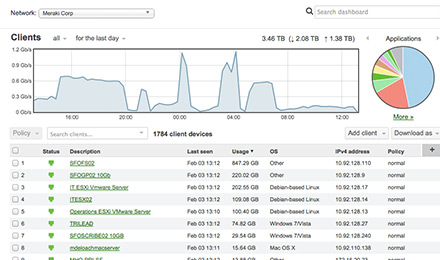
Cisco Meraki IWAN
IWAN features for all MX Security Appliances
Overview:
What is IWAN?
Intelligent WAN, or IWAN, is a collection of Cisco technologies and products that lowers operational costs and improves resource usage for multi-site deployments, allowing network administrators to use bandwidth more efficiently and ensure the highest possible level of performance for critical applications without sacrificing security or data privacy.

Transport Independence
Easy-to-configure IPsec overlay using Meraki Auto VPN
Traffic distribution over multiple pathways (Internet, cellular, MPLS) with built-in load balancing and automatic failover capabilities

Application Optimization
Centralized network visibility and control
QoS and bandwidth management with Meraki traffic shaping

Intelligent Path Control
Policy-based routing: Traffic path assigned based on source, destination, or application
Dynamic path selection: Traffic path chosen per-application based on loss, latency, and jitter

Secure Connectivity
Intuitive, scalable VPN solution to connect remote sites with ease (Auto VPN)
AES encryption to ensure data privacy
Why Choose IWAN?
Today, IT departments are under pressure to do more with less: manage more sites and more clients with limited budgets and a relatively small team, all without any reduction in reliability and security. The high cost of MPLS for WAN connectivity, combined with the growth of bandwidth-hungry streaming applications and cloud-based services, is forcing many network admins to search for alternative solutions.
Enter IWAN. With IWAN, remote sites are connected over low-cost Internet links secured by VPN. MPLS-like reliability is provided through multiple uplinks with load balancing capabilities, intelligent path control, and automatic failover.

New IWAN Features:
Dual-Active VPN uplinks
MX Security Appliances already support dual WAN uplinks and automatic VPN failover. The new IWAN features will allow VPN tunnels to be active simultaneously on both uplinks, whether they are Internet or MPLS connections. Traffic can then be load-balanced across these tunnels to make optimal use of available bandwidth.
Policy-Based Routing (PbR)
PbR functionality allows administrators to assign traffic to a particular VPN path based on criteria such as traffic protocol, source, destination, or application.
Dynamic path selection
Dynamic path selection allows administrators to set performance thresholds for different types of traffic, in order to ensure that critical applications and data transfers always use the best path based on the loss, latency, and jitter over the available VPN tunnels.
Case Study:
Deep dive: Penn Mutual saves $858K

Goals
- Implement a BYOD platform at 50 remote sites
- Reduce Managed Service Provider & MPLS costs
Solution
- Complete Meraki hardware stack: MX, MS, MR
- Phase out MPLS in favor of Broadband
Business Outcomes
- Reduced Telco spend by 40%
- Improved IT efficiency with unified management platform
| Projected 3 year cost with legacy WAN deployment | |
|---|---|
| Internet Connectivity | $2,016,000 |
| T1 Internet × 45 at branches (1.544Mbps each) | $582,000/yr |
| Broadband × 2 at HQ & DR (45Mbps each) | $90,000/yr |
| Content Management | $153,000 |
| Content filtering software | $51,000/yr |
| Maintenance | $24,750 |
| Hardware Security Appliance | $8,250/yr |
| 3 year Total Cost of Ownership (TCO) | $2,193,750 |
| Projected 3 year cost with Meraki (including rip & replace) | |
|---|---|
| Internet Connectivity | $673,495 |
| Broadband × 38 at HQ & branches (50Mbps each) | $212,040/yr |
| WAN Management vendor (one time installation costs) | $37,375 |
| Meraki Hardware & Licensing | $599,141 |
| MX, MS, and MR × 41 at branches | $382,896 |
| MX, MS, and MR licensing | $72,081/yr |
| Content Management | Included |
| Wireless Installation | $62,257 |
| 26 branch offices wired for MR | $62,257 |
| 3 year Total Cost of Ownership (TCO) | $1,334,893 |
